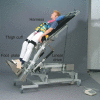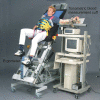Influence of passive leg movements on blood circulation on the tilt table in healthy adults
- PMID: 15679913
- PMCID: PMC544951
- DOI: 10.1186/1743-0003-1-4
Influence of passive leg movements on blood circulation on the tilt table in healthy adults
Abstract
BACKGROUND: One problem in the mobilization of patients with neurological diseases, such as spinal cord injury, is the circulatory collapse that occurs while changing from supine to vertical position because of the missing venous pump due to paralyzed leg muscles. Therefore, a tilt table with integrated stepping device (tilt stepper) was developed, which allows passive stepping movements for performing locomotion training in an early state of rehabilitation. The aim of this pilot study was to investigate if passive stepping and cycling movements of the legs during tilt table training could stabilize blood circulation and prevent neurally-mediated syncope in healthy young adults. METHODS: In the first experiment, healthy subjects were tested on a traditional tilt table. Subjects who had a syncope or near-syncope in this condition underwent a second trial on the tilt stepper. In the second experiment, a group of healthy subjects was investigated on a traditional tilt table, the second group on the tilt ergometer, a device that allows cycling movements during tilt table training. We used the chi-square test to compare the occurrence of near-syncope/syncope in both groups (tilt table/tilt stepper and tilt table/tilt ergometer) and ANOVA to compare the blood pressure and heart rate between the groups at the four time intervals (supine, at 2 minutes, at 6 minutes and end of head-up tilt). RESULTS: Separate chi-square tests performed for each experiment showed significant differences in the occurrence of near syncope or syncope based on the device used. Comparison of the two groups (tilt stepper/ tilt table) in experiment one (ANOVA) showed that blood pressure was significantly higher at the end of head-up tilt on the tilt stepper and on the tilt table there was a greater increase in heart rate (2 minutes after head-up tilt). Comparison of the two groups (tilt ergometer/tilt table) in experiment 2 (ANOVA) showed that blood pressure was significantly higher on the tilt ergometer at the end of head-up tilt and on the tilt table the increase in heart rate was significantly larger (at 6 min and end of head-up tilt). CONCLUSIONS: Stabilization of blood circulation and prevention of benign syncope can be achieved by passive leg movement during a tilt table test in healthy adults.
Figures









Similar articles
-
Midodrine in neurally mediated syncope: a double-blind, randomized, crossover study.Ann Neurol. 2002 Sep;52(3):342-5. doi: 10.1002/ana.10293. Ann Neurol. 2002. PMID: 12205647 Clinical Trial.
-
Is home orthostatic self-training effective in preventing neurally mediated syncope?Pacing Clin Electrophysiol. 2007 May;30(5):638-43. doi: 10.1111/j.1540-8159.2007.00725.x. Pacing Clin Electrophysiol. 2007. PMID: 17461874 Clinical Trial.
-
Distinctive Steady-State Heart Rate and Blood Pressure Responses to Passive Robotic Leg Exercise during Head-Up Tilt: A Pilot Study in Neurological Patients.Front Physiol. 2017 Jun 2;8:327. doi: 10.3389/fphys.2017.00327. eCollection 2017. Front Physiol. 2017. PMID: 28626427 Free PMC article.
-
Comparison of orthostatic reactions of patients still unconscious within the first three months of brain injury on a tilt table with and without integrated stepping. A prospective, randomized crossover pilot trial.Clin Rehabil. 2008 Dec;22(12):1034-41. doi: 10.1177/0269215508092821. Clin Rehabil. 2008. PMID: 19052242 Clinical Trial.
-
Neurologic and musculoskeletal effects of tilt-table standing on adults: a systematic review.J Phys Ther Sci. 2021 Sep;33(9):700-706. doi: 10.1589/jpts.33.700. Epub 2021 Sep 1. J Phys Ther Sci. 2021. PMID: 34539077 Free PMC article. Review.
Cited by
-
Sympathetic activity and early mobilization in patients in intensive and intermediate care with severe brain injuries: a preliminary prospective randomized study.BMC Neurol. 2016 Sep 13;16(1):169. doi: 10.1186/s12883-016-0684-2. BMC Neurol. 2016. PMID: 27619015 Free PMC article. Clinical Trial.
-
Cardiovascular control and stabilization via inclination and mobilization during bed rest.Med Biol Eng Comput. 2014 Jan;52(1):53-64. doi: 10.1007/s11517-013-1119-5. Epub 2013 Oct 7. Med Biol Eng Comput. 2014. PMID: 24096595
-
Effects of Gait Rehabilitation Robot Combined with Electrical Stimulation on Spinal Cord Injury Patients' Blood Pressure.Sensors (Basel). 2025 Feb 6;25(3):984. doi: 10.3390/s25030984. Sensors (Basel). 2025. PMID: 39943623 Free PMC article.
-
Acute orthostatic responses during early mobilisation of patients with acquired brain injury - Innowalk pro versus standing frame.J Rehabil Assist Technol Eng. 2024 May 10;11:20556683241240488. doi: 10.1177/20556683241240488. eCollection 2024 Jan-Dec. J Rehabil Assist Technol Eng. 2024. PMID: 38737723 Free PMC article.
-
Acute effects of 10-minute robotic leg movements on a dynamic tilt table in patients with chronic stroke.J Phys Ther Sci. 2025 Jul;37(7):330-335. doi: 10.1589/jpts.37.330. Epub 2025 Jul 1. J Phys Ther Sci. 2025. PMID: 40599832 Free PMC article.
References
-
- Graybiel A, McFarland RA. The use of the tilt table in aviation medicine. Aviat Med. 1941;11:194–211.
-
- Morillo C, Eckberg D, Ellenbogen K, Beightol L, Hoag J, Tahvanainen K, Kuusela T, Diedrich A. Vagal and Sympathetic Mechanisms in Patients With Orthostatic Vasovagal Syncope. Circulation. 1997;96:2509–2513. - PubMed
-
- Oberg B, Thorne P. Increased activity in the left ventricular receptors during hemorrhage or occlusion of caval veins in the cat: a possible cause of the vasovagal reaction. Acta Physiol Scand. 1972;85:164–173. - PubMed
LinkOut - more resources
Full Text Sources
Medical

